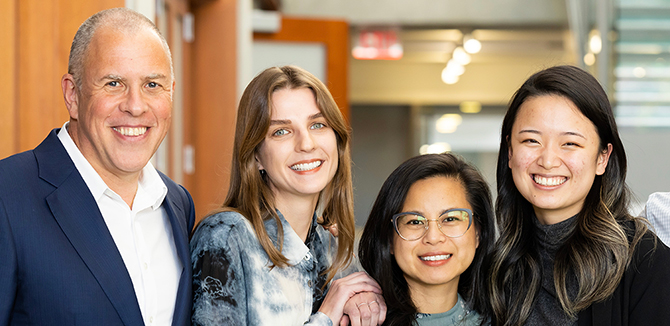Aging With Autonomy
A team of mpd² students is refining a product concept to detect when an older person falls, initiates the rescue, and provides health insights for their capstone project.

One in every four adults aged 65 or over falls every year, and it is common for hours to pass between when they fall and are rescued. In fact, falls are the leading cause of injury and injury death among this older population in the United States.
Those statistics were the inspiration for Courtney Mayszak (mpd² '24), Adrian Novik (mpd² '24), Yim Yan (mpd² '24), and Cindy Zhang (mpd² '24), who are collaborating on a new product concept for their capstone project in Northwestern Engineering's Master of Product Design and Development Management (mpd²) program.
As the students begin their final quarter in the program, they are refining their idea that combines hardware, software, and data analysis to detect falls and respond quickly with help. Their plan is for the product to provide health insights related to mobility health as well.
"We found evidence through research and interviews that this topic is a growing need," Novik said. "For example, in 2018, people over the age of 65 outnumbered children under 5 for the first time. There is a growing need to alleviate the burden that caregivers carry."
Capstone is the culminating activity in the mpd² program. Over three quarters, students dive deeply into a topic of personal interest to design a product or service that answers an unaddressed customer need.
Mayszak, Novik, Yan, and Zhang began the capstone process knowing they wanted to focus on the ideas of aging and autonomy. With life expectancy and technological health advancements both increasing, the team members wondered how they could contribute toward improved quality of life — both for older people as well as their caregivers.
"The space resonates with us because of our personal aging journeys and experiences with our older loved ones," Novik said. "We know first-hand the burden that family members, especially those in caregiving roles, carry as they care for their aging loved ones and adapt to their evolving needs."
The team's research highlighted environmental and behavioral adjustments older people and their caregivers confront after a fall, including psychological and social-emotional changes. They also found that falls can lead to changing dynamics in the relationship between caregivers and their loved one who fell.
It was not until February and March that the team committed to its fall detection solution as its capstone project.
As the students enter their final quarter in the program, they are focused on developing a viable, desirable, and feasible solution while communicating a compelling story about why their solution is needed.
The journey has not been easy.
The team learned the value of effective communications — both speaking and listening — and found that while interviews are critical, so too, are meaningful questions that frame a problem and opportunity space. Time management, team dynamics, and team decision making are all a work in progress. The team also said it was a challenge to use information it was still shaping to pick a "best choice" decision in order to continue moving the project forward in the sprint process.
The more they talk about their project, though, the more confident they get.
"Solutions for older adults have the opportunity to evolve as healthcare, technology, and demographic shifts occur," Novik said. "The response we receive from friends, families, and colleagues as we share our project also continues to confirm to us that this topic is ripe for innovation and increases our desire to help find a solution in this space."
